CIVIL TECHNOLOGY: CIVIL SERVICES GRADE 12 QUESTIONS - NSC EXAMS PAST PAPERS AND MEMOS NOVEMBER 2018
Share via Whatsapp Join our WhatsApp Group Join our Telegram GroupCIVIL TECHNOLOGY: CIVIL SERVICES
GRADE 12
NSC EXAMS
PAST PAPERS AND MEMOS
NOVEMBER 2018
REQUIREMENTS:
- Drawing instruments
- A non-programmable calculator
- ANSWER BOOK
INSTRUCTIONS AND INFORMATION
- This question paper consists of SIX questions.
- Answer ALL the questions.
- Answer each question as a whole. Do NOT separate subsections of questions.
- Start the answer to EACH question on a NEW page.
- Do NOT write in the margins of the ANSWER BOOK.
- You may use sketches to illustrate your answers.
- Write ALL calculations and answers in the ANSWER BOOK or on the attached ANSWER SHEETS.
- Use the mark allocation as a guide to the length of your answers.
- Make drawings and sketches in pencil, fully dimensioned and neatly finished off with descriptive titles and notes to conform to the SANS/SABS Code of Practice for Building Drawings.
- For the purpose of this question paper, the size of a brick should be taken as 220 mm x 110 mm x 75 mm.
- Use your own discretion where dimensions and/or details have been omitted.
- Answer QUESTIONS 2, 3.2, 3.6, 5.2, 5.3 and 6.3 on the attached ANSWER SHEETS using drawing instruments where necessary.
- Write your CENTRE NUMBER and EXAMINATION NUMBER on every ANSWER SHEET and hand them in with your ANSWER BOOK, whether you have used them or not.
- Drawings in the question paper are NOT to scale due to electronic transfer.
- Google Images was used as the source for all photographs and pictures.
QUESTIONS
QUESTION 1: OHSA, MATERIALS, TOOLS, EQUIPMENT AND JOINING (GENERIC)
Start this question on a NEW page.
1.1 Choose a description from COLUMN B that matches an item in COLUMN A. Write only the letter (A–G) next to the question numbers (1.1.1 to 1.1.5) in the ANSWER BOOK, e.g. 1.1.6 H.
COLUMN A | COLUMN B |
1.1.1 Sole plate 1.1.2 Aluminium ladder 1.1.3 Scaffold 1.1.4 Safety net 1.1.5 Galvanising |
(5 x 1) (5) |
1.2 Describe TWO safety precautions that must be adhered to when working on a scaffold. (2)
1.3 What is the purpose of the guard rail of a scaffold in terms of safety? (2)
1.4 Explain the purpose of painting. (2)
1.5 Describe ONE advantage of the curing process of concrete. (1)
1.6 FIGURE 1.6 below shows a tool that is used in the building construction industry. 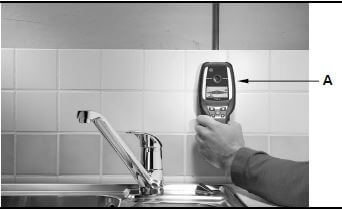
FIGURE 1.6
1.6.1 Identify tool A. (1)
1.6.2 Explain TWO uses of tool A. (2)
1.6.3 Explain why the batteries should be removed from the tool if the tool is not going to be used for a long time. (1)
1.7 FIGURE 1.7 below shows joining fixtures that are used on building sites and in workshops. 
FIGURE 1.7
1.7.1 Identify fastener A and fastener B. (2)
1.7.2 Explain ONE use of fastener A and fastener B respectively. (2) [20]
QUESTION 2: GRAPHICS AS METHOD OF COMMUNICATION (GENERIC)
FIGURE 2 on the next page shows different drawings that appear on a building plan. Analyse the drawings and complete the table on ANSWER SHEET 2. 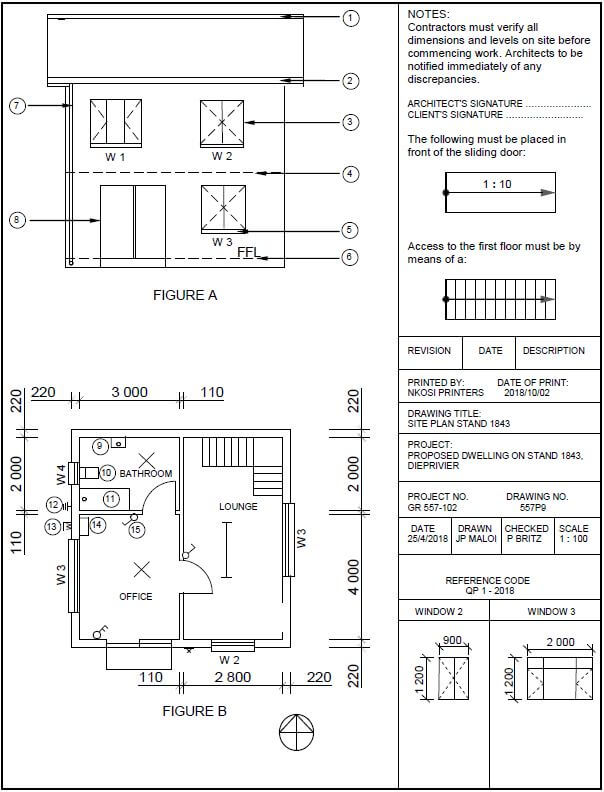
FIGURE 2 [40]
QUESTION 3: CONSTRUCTION ASSOCIATED WITH CIVIL SERVICES, OHSA AND QUANTITIES (SPECIFIC)
Start this question on a NEW page.
3.1 FIGURE 3.1 below shows a sectional view of a manhole. Study the drawing and answer the questions that follow. 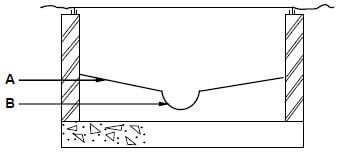
FIGURE 3.1
3.1.1 What is the main function of a manhole? (1)
3.1.2 Identify A. (1)
3.1.3 Identify B. (1)
3.1.4 Manholes that are deeper than 750 mm should be set in frames and have greased double seals. Give TWO reasons why greased double seals are installed. (2)
3.2 ANSWER SHEET 3.2 shows a top view of a T-junction of a half-brick wall in stretcher bond built with common bricks. Draw the sectional front view on section A-A by projecting it from the top view. The front view must have FIVE brick courses. (10)
3.3 State THREE regulations that protect workers during excavations. (3)
3.4 FIGURE 3.4 below shows TWO different types of shoring/shuttering. 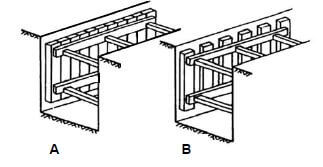
FIGURE 3.4
3.4.1 Different types of shoring are used for different soil types. Which type of shoring, A or B, will be suitable to use in loose or water-logged soil? (1)
3.4.2 Motivate your answer to QUESTION 3.4.1. (1)
3.5 Choose the correct word(s)/term in brackets. Write only the word(s)/term next to the question numbers (3.5.1 to 3.5.2) in the ANSWER BOOK.
3.5.1 Working in confined spaces, such as a (manhole/french drain/excavation), is one of the most dangerous tasks. (1)
3.5.2 A safety harness is clipped to a rope known as a (safety rope/ lifeline). (1)
3.6 FIGURE 3.6 below shows an incomplete sectional view through the bricks and concrete floor slab of a manhole.
Use ANSWER SHEET 3.6 and answer the following questions. 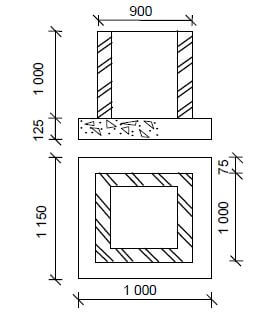
FIGURE 3.6
3.6.1 Calculate the volume of concrete that will be used for the foundation. Round off your answer to TWO decimals. (4)
3.6.2 Calculate the number of bricks needed for the manhole.
Specifications:
- The wall is a one-brick wide wall
- The centre line for the brickwork of the manhole is 4,96 m
- 100 bricks per square metre (m²) are needed for a one-brick wall (4)
[30]
QUESTION 4: COLD AND HOT-WATER SUPPLY, TOOLS, EQUIPMENT AND MATERIALS (SPECIFIC)
Start this question on a NEW page.
4.1 FIGURE 4.1 below shows a geyser. 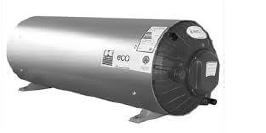
FIGURE 4.1
4.1.1 Identify the type of geyser in FIGURE 4.1 above. (1)
4.1.2 Which part inside the geyser heats the water? (1)
4.1.3 Geysers use a lot of electricity. Recommend ONE other device that can be used to heat water without using electricity. (1)
4.2 Many different faults can occur in hot-water systems. Describe ONE cause of the following faults in hot-water systems:
4.2.1 Dripping geyser overflow (1)
4.2.2 No hot water (1)
4.2.3 Water leaking through the ceiling (1)
4.3 Choose a description from COLUMN B that matches an item in COLUMN A. Write only the letter (A–G) next to the question numbers (4.3.1 to 4.3.5) in the ANSWER BOOK, e.g. 4.3.6 H.
COLUMN A | COLUMN B |
4.3.1 Vacuum breaker 4.3.2 Heat pump 4.3.3 Pressure control valve 4.3.4 Electrical isolator 4.3.5 Water tank |
(5 x 1) (5) |
4.4 Draw the SANS approved symbols for the followings fittings used in hot water systems:
4.4.1 Automatic shut-off valve (2)
4.4.2 Non-return valve (2)
4.4.3 Pressure reducing valve (2)
4.5 Explain, in FOUR steps, how you would fix a leaking copper pipe with compression joints. The water supply is already shut off. (4)
4.6 FIGURE 4.6 below shows a fitting that can be used under a wash basin. 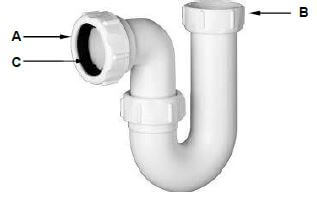
FIGURE 4.6
4.6.1 Identify the fitting in FIGURE 4.6. (1)
4.6.2 Name the material that is used to manufacture this fitting. (1)
4.6.3 Which part, A or B, will be connected to the bottom of the wash basin? (1)
4.6.4 Describe the purpose of the seal at C. (1)
4.7 FIGURE A and FIGURE B below show two different types of taps. 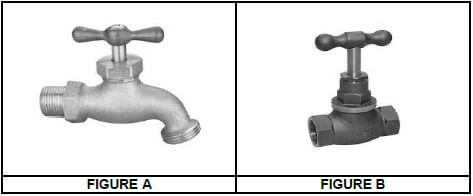
4.7.1 Identify the taps in FIGURES A and B respectively. (2)
4.7.2 Describe where you would use EACH of the taps above. (2)
4.7.3 Explain the advantage of plastic taps over brass taps on the outside of a building. (1)
4.8 Explain the purpose of installing a water meter on the incoming supply pipe of a house. (1)
4.9 Materials react differently when used.
4.9.1 Describe dezincification. (2)
4.9.2 Describe the problems dezincification can cause. (3)
4.10 Recommend ONE method to remove scale or corrosion from a metal surface. (1)
4.11 One function of a centrifugal pump is to convert kinetic energy to another type of energy. Name this type of energy. (1)
4.12 Which tool would you use to clear blockages in drains? (1)
4.13 Recommend ONE tool that can be used to test for leakages in a below ground drainage system. (1) [40]
QUESTION 5: GRAPHICS AS MEANS OF COMMUNICATION, ROOF WORK AND STORM WATER (SPECIFIC)
Start this question on a NEW page.
5.1 Give ONE word(s)/term for EACH of the following descriptions by choosing a word(s)/term from the list below. Write only the word(s)/term next to the question numbers (5.1.1 to 5.1.5) in the ANSWER BOOK, e.g. 5.1.6 Vacuum breaker.
length of the roof; galvanised sheet metal; gutter seal; concrete shoe; manhole; pitch of the roof; stop end; gutter; kerb |
5.1.1 This fitting can be used to seal off the gutter at the ends (1)
5.1.2 One factor to consider before installing a flashing (1)
5.1.3 A material that can be used for flashings (1)
5.1.4 This part collects rainwater flowing from the roof (1)
5.1.5 A raised edge on the road that guides water to storm-water drains (1)
5.2 FIGURE 5.2 on ANSWER SHEET 5.2 shows an incomplete drawing of a roof construction. Complete the drawing of the roof by drawing the following parts:
5.2.1 Square gutter (2)
5.2.2 Down-pipe with offset (3)
5.2.3 Holderbat (2)
5.3 ANSWER SHEET 5.3 shows the front and top view of a frustrum of a cone where the top is not parallel to the base.
Use the drawing and information on the ANSWER SHEET and draw the development of the cone. The development must have a 3 mm seam on both sides.
Show ALL construction lines. Do NOT redraw the drawing, project the development from the given drawing. (18) [30]
QUESTION 6: SEWERAGE, SANITARY FITTINGS AND JOINING (SPECIFIC)
Start this question on a NEW page.
6.1 Various options are given as possible answers to the following questions. Choose the answer and write only the letter (A–D) next to the question numbers (6.1.1 to 6.1.5) in the ANSWER BOOK, e.g. 6.1.6 C.
6.1.1 An inspection eye is placed at … in the drainage system.
- rodding eyes
- junctions
- gully's
- All the above-mentioned (1)
6.1.2 Glue can be used to join … pipes.
- PVC
- copper and PVC
- copper and galvanised
- copper, PVC and galvanised (1)
6.1.3 A straight pan collar is used to join the … to the discharge pipe.
- toilet pan
- T-junction
- straight couplings
- cross junction (1)
6.1.4 The … allows odours and gases to escape from the drainage system.
- wastewater pipe
- soil pipe
- soil vent pipe
- All the above-mentioned (1)
6.1.5 All branch pipes should join the main drain at an angle of …
- 90°
- 135°
- 120°
- None of the above-mentioned (1)
6.2 FIGURE 6.2 below shows a part of a sewerage system. Study the drawing and answer the questions that follow. 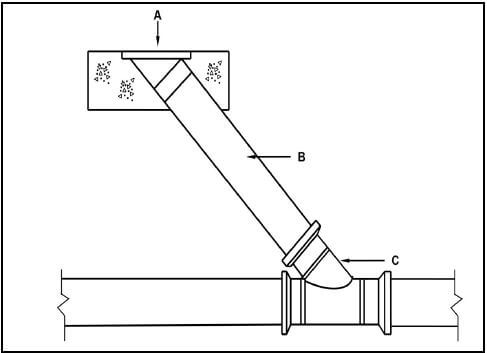
FIGURE 6.2
6.2.1 Identify component C. (1)
6.2.2 Describe ONE purpose of A. (1)
6.2.3 Explain why B is at an angle with the main pipe. (1)
6.3 FIGURE 6.3 on ANSWER SHEET 6.3 shows the line diagram of part of a building with sanitary fitments and sewerage components. Use ANSWER SHEET 6.3 and develop and draw a one-pipe sewerage layout for this building up to the indicated manhole. ALL regulations and design principles of a good drainage (sewerage) system must be considered and appropriate symbols and abbreviations must be used.
The drainage system should consist of:
- 2 x rodding eyes
- 5 x inspection eyes
- 1 x ventilation pipe
- Main sewerage pipes
- Branch pipes (10)
6.4 FIGURE 6.4 below shows the incomplete sectional view of a shower installation.
Study FIGURE 6.4 and answer the questions that follow. 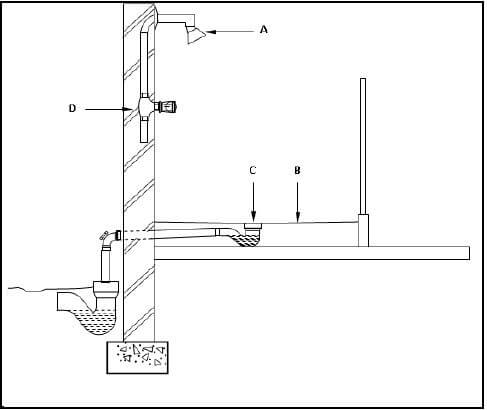
FIGURE 6.4
6.4.1 What is the diameter of the water pipes that are usually used for a shower? (1)
6.4.2 Identify A. (1)
6.4.3 Why is the surface B sloped towards C? (1)
6.4.4 Describe the function of C. (1)
6.4.5 The pipework from fitting A to fitting D consists of copper pipes. Name ONE method of joining these pipes if you are unable to use a compression joint. (1)
6.5 Explain the function of an anti-siphonage pipe. (1)
6.6 Differentiate between FIGURE A and FIGURE B below in terms of their use.  (2)
(2)
6.7 Name ONE sanitary appliance that discharges soil water. (1)
6.8 Draw the SANS approved symbols for the following components:
6.8.1 Urinal (2)
6.8.2 Grease trap (2)
6.8.3 Shower (2)
6.9 Name TWO materials that are commonly used in the manufacturing of sanitary fittings. (2)
6.10 Name TWO types of solder that can be used in the building industry. (2)
6.11 Give ONE use of a chemical anchor. (1)
6.12 FIGURE 6.12 below shows a joint between two pieces of metal. Study the drawing and answer the questions that follow. 
FIGURE 6.12
6.12.1 Identify A. (1)
6.12.2 Explain the function of B. (1) [40]
TOTAL: 200
EXAMINATION NUMBER: |
CENTRE NUMBER: |
ANSWER SHEET 2
NO. | QUESTIONS | ANSWERS | MARKS |
1 | Identify FIGURE A. | 1 | |
2 | Identify FIGURE B. | 1 | |
3 | Identify number 4. | 1 | |
4 | Identify number 5. | 1 | |
5 | Identify number 9. | 1 | |
6 | Identify number 10. | 1 | |
7 | Identify number 11. | 1 | |
8 | On what date was the plan printed? | 1 | |
9 | Who drew the building plan? | 1 | |
10 | Name the feature in the column for the notes in FIGURE 2 that must be installed in front of the sliding door. | 1 | |
11 | Name the feature in the column for the notes in FIGURE 2 that must give access to the first floor. | 1 | |
12 | Identify the type of roof that is used for the building in FIGURE A. | 1 | |
13 | Explain the purpose of number 1. | 1 | |
14 | Explain the purpose of number 2. | 1 |
15 | Explain the abbreviation FFL at number 6. | 1 | |
16 | Explain the purpose of number 7. | 1 | |
17 | Explain the meaning of the arrow on the feature that must be installed in front of the sliding door. | 1 | |
18 | Explain what is meant by 1 : 10 indicated on the symbol in the notes. | 1 | |
19 | Which room will feature 15 serve? | 1 | |
20 | Explain the short dashed lines on the windows. | 1 | |
21 | Deduce the height of window 2 from the window schedule. | 1 | |
22 | Deduce the width of window 3 from the window schedule. | 1 | |
23 | On what elevation of the building is the bathroom window situated? | 1 | |
24 | Differentiate between component number 3 and component number 8. | 2 | |
25 | Differentiate between the light in the lounge and the light in the bathroom. | 2 | |
26 | Recommend a suitable floor covering for the bathroom. | 1 | |
27 | Recommend an appropriate scale to which FIGURE A should be drawn, according to SANS. | 1 | |
28 | Recommend an alternative sanitary fitment to replace number 11 that will serve a similar purpose. | 1 |
29 | Calculate the internal area of the office in m². Show ALL calculations. | 3 | |
30 | Calculate the perimeter of the building. Show ALL calculations. | 7 | |
TOTAL | 40 |
CENTRE NUMBER: |
EXAMINATION NUMBER: |
ANSWER SHEET 3.2 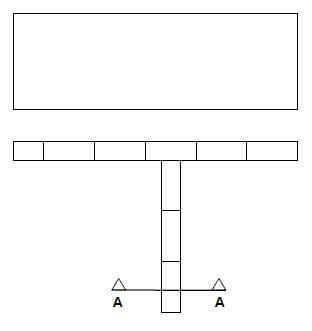
ASSESSMENT CRITERIA | MARK | CANDIDATE'S MARK |
FIVE courses of bricks in stretcher bond correctly drawn | 5 | |
Alternate corner bricks on left side | 3 | |
Section correctly drawn | 1 | |
Hatching lines | 1 | |
TOTAL: | 10 |
CENTRE NUMBER: |
EXAMINATION NUMBER: |
ANSWER SHEET 3.6
A | B | C | D | ||
3.6.1 | Volume of concrete for foundation: | ||||
Volume = ℓ x b x h | |||||
1/ | ________ | ||||
________ | |||||
________ | ________ | ________ m³ of concrete is needed | (4) | ||
3.6.2 | Number of bricks needed for the manhole: | ||||
1/ | ________ | Centre line of wall = 4,96 m | |||
________ | |||||
________ | ________ | ________ bricks are needed | (4) | ||
CENTRE NUMBER: |
EXAMINATION NUMBER: |
ANSWER SHEET 5.2 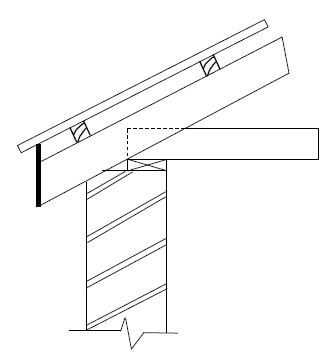
FIGURE 5.2
ASSESSMENT CRITERIA | MARK | CANDIDATE'S MARK |
Square gutter | 2 | |
Down-pipe with offset | 3 | |
Holderbat | 2 | |
TOTAL: | 7 |
CENTRE NUMBER: |
EXAMINATION NUMBER: |
ANSWER SHEET 5.3 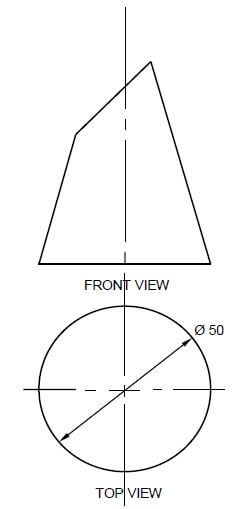
ASSESSMENT CRITERIA | MARK | CM |
Construction lines to top of cone | 2 | |
Construction lines of outer circle | 2 | |
Divide outer circle in 12 parts | 1 | |
Construction lines from top of cone to outer circle | 3 | |
Cone measurement (marked/transferred) from front view to determine top part of development | 6 | |
Outside lines of development | 2 | |
3 mm seam on both sides | 2 | |
TOTAL: | 18 |
CENTRE NUMBER: |
EXAMINATION NUMBER: |
ANSWER SHEET 6.3 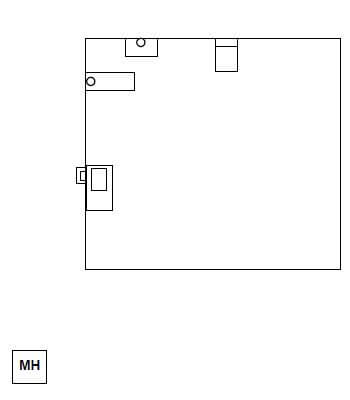
ASSESSMENT CRITERIA | MARK | CANDIDATE'S MARK |
2 x rodding eyes correctly positioned | 2 | |
5 x inspection eyes correctly positioned | 5 | |
1 x ventilation pipe correctly positioned | 1 | |
Drain pipes drawn correctly (main and branch pipes) | 2 | |
TOTAL | 10 |